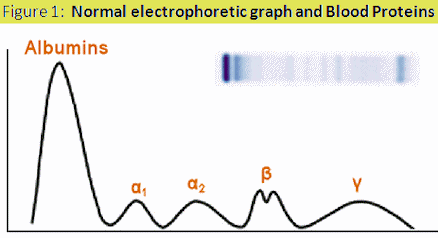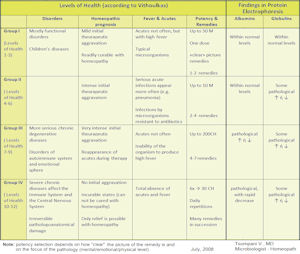Reasearch & Homeopathy: Protein Electrophoresis and Levels of Health
Protein Electrophoresis and Levels of Health
Forecast Announcement of Research and Results
From: HomeoNews, issue 9, pages 9-10, 2008 Jun-Jul-Aug (PDF, in greek)
Prof George Vithoulkas, Director of International Academy of Classical Homeopathy
Vasso Tsompani, MD, Microbiologist - Homeopath
SUMMARY:
This research project explores and investigates a) the connection between protein electrophoresis and the levels of health (according to Prof Vithoulkas), and b) the possibility of using electrophoresis of blood proteins (plasma or serum) as a diagnostic tool in conjunction with the patient's interview, in order to estimate:
1) The patient's Level of Health, prior to homeopathic treatment
2) The selection of the appropriate potency of the remedy and the possibilities of repetition
3) The progress of the patients' health and the results of homeopathic treatment
The estimation of the patient's Level of Health is based on Prof Vithoulkas' theory of Levels of Health (Group I, II, III, IV). The Levels of Health are part of homeopathic theory and consist of an important and innovative part of the model of the defensive mechanism, connecting chronic and acute diseases. According to Prof Vithoulkas' theory, a strong defense mechanism (Group I, II) can reverse even the course of a serious disease, with the help of appropriate therapeutic intervention, such as homeopathy. Protein electrophoresis is an important source of information concerning the defense mechanism, in its analytic evaluation of the deviations of albumin, globulin and of other blood proteins.
The electrophoretic graph is the interpretation of protein electrophoresis and includes a variety of proteins. A normal graph of protein electrophoresis is shown in Figure 1.

Normal values of albumins and globulins
(normal values can show small variations depending on the measuring method)
| Proteins | Normal values | |
| Albumins | 55.8 - 65% | - |
| α1 | 2.2 - 4.6 % | α1-Antitrypsin, TBG, Transcortin, etc |
| α2 | 8.2 - 12.5 % | Haptoglobulin, ceruloplasmin, α2- macroglobulin, etc |
| β(1+2) | 7.2 - 14.2 % | β1-transferin, β-lipoprotein, etc |
| γ | 11.5 - 18.8 % | Antibodies, etc |
The albumins are primarily involved in maintaining the osmotic pressure of blood plasma, whereas the globulins are considered to be integral in the main transport system of many substances, and play an active role in the various immunological mechanisms.
Table: Levels of Health and Protein Electrophoresis

View the above table in *.doc format: Homeopathy: Levels of Health and Protein Electrophoresis
Note: potency selection depends on how "clear" the picture of the remedy is and on the focus of the pathology (mental/emotional/physical level)
RESULTS:
In the current sample of cases that have been investigated, the following have been observed:
1st group of patients (and beginning of 2nd group): where disorders are simply functional it has been observed that in functional disorders of the organs, there is no electrical change in protein electrophoresis (for functional disorders, responsible is the Autonomous Nervous System and the Glandular system). In the 1st group we observe a normal graph in protein electrophoresis and a "clear" picture of a homeopathic remedy, with a very good prognosis for the patient's health, under homeopathic treatment.
2nd group of patients: in lesional disorders, where the immunological response is very good, independent of disease, we have observed electrophoretic graphs with albumins within normal levels and with small pathological deviations of some globulins. In the 2nd group we observe a "clear" picture of a homeopathic remedy, with a good prognosis for the patient's health, under correct and appropriate homeopathic treatment.
3rd group of patients: in diseases where the disorder is marginally non-reversible, there are important deviations in the electrophoretic graph, with pathological albumins (increased or decreased levels) and also some pathological globulins, depending on the disease, with worsening of their values while the patient's status goes towards a non-reversible state. In this group, the homeopathic treatment can "halt" the development of the disease, or even increase the patient's level of health, in which case there will be observed improvements in the levels of albumins and balancing in the levels of globulins.
4th group of patients: the electrophoretic graph is pathological (rapid intense decrease of albumins) and the state of the patient is irreversible.
This research began 3 years ago and has intensified since October 2007, with the help and guidance of Prof Vithoulkas. The anticipation is to complete this research project in the near future with the integration of more cases in addition to the current sample. This research is part of Mrs Tsompani's thesis for the MSc in Classical Homeopathy by the University of Aegean (Greece).
Information
For more information regarding the current research, please contact the director of the project, Mrs Vasso Tsompani, MD, Microbiologist - Homeopath,
dpsdh07037 syros.aegean.gr, tel (+30)6973.457.747 , (+30) 6933.344.892 or Prof George Vithoulkas.
syros.aegean.gr, tel (+30)6973.457.747 , (+30) 6933.344.892 or Prof George Vithoulkas.